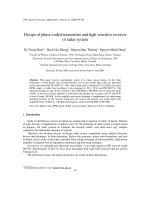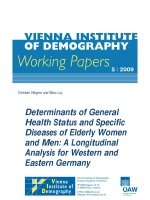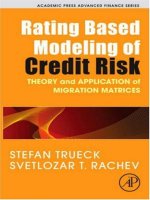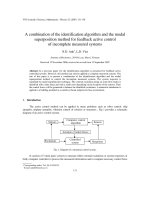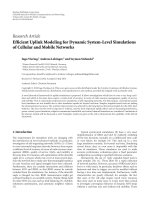System level modeling of endothelial permeability pathway and high throughput data analysis for disease biomarker selection
Bạn đang xem bản rút gọn của tài liệu. Xem và tải ngay bản đầy đủ của tài liệu tại đây (3.18 MB, 249 trang )
SYSTEM-LEVEL MODELING OF ENDOTHELIAL
PERMEABILITY PATHWAY AND HIGH-THROUGHPUT
DATA ANALYSIS FOR DISEASE BIOMARKER
SELECTION
WEI XIAONA
(M.Sc., Nankai University)
A THESIS SUBMITTED
FOR THE DEGREE OF DOCTOR OF PHILOSOPHY
IN COMPUTATION AND SYSTEMS BIOLOGY (CSB)
SINGAPORE-MIT ALLIANCE
NATIONAL UNIVERSITY OF SINGAPORE
2012
DECLARATION
DECLARATION
I hereby declare that this thesis is my original work and it has been
written by me in its entirety.
I have duly acknowledged all the sources of information which
have been used in the thesis.
This thesis has also not been submitted for any degree in any
university previously.
WEI XIAONA
1st August 2012
I
ACKNOWLEDGEMENTS
ACKNOWLEDGEMENTS
First and foremost, my heartfelt appreciation and thanks go to my supervisor
and mentor, Professor Chen Yu Zong, for his excellent supervision, invaluable
advices and constructive suggestions throughout my whole research progress.
I have tremendously benefited from his profound knowledge, expertise in
scientific research, as well as his enormous support, which will inspire and
motivate me to go further in my future professional career. My many thanks
also go to my co-supervisor Professor Bruce Tidor and Associate Professor
Low Boon Chuan. Thank you for their good suggestion for my project and
invaluable encouragement.
I would like to dedicate my thesis to my parents, my husband, and my lovely
son. The beautiful time and memories we have in Singapore are definitely
great treasures in my life, I cherish it very much. And I am eternally grateful
for everything you do for me, I appreciate it very much.
Special thanks go to our present and previous BIDD Group members. Without
their help and group effort, this work could not be properly finished. I thank
them for their valuable support and encouragement in my work.
Finally, I am very grateful to the Singapore-MIT Alliance, National University
of Singapore for awarding me the Research Scholarship.
II
TABLE OF CONTENTS
TABLE OF CONTENTS
DECLARATION................................................................................................ I
ACKNOWLEDGEMENTS .............................................................................. II
TABLE OF CONTENTS ................................................................................. III
SUMMARY .................................................................................................. VIII
LIST OF ABBREVIATIONS ........................................................................ XV
Chapter 1 Introduction ....................................................................................... 1
1.1 Introduction to endothelial permeability and related disease ............... 2
1.1.1 Overview of endothelial permeability ........................................ 2
1.1.2 Molecular mechanism of endothelial permeability..................... 3
1.1.3 Endothelia permeability related disease - Sepsis ........................ 8
1.2 Overview of mathematical modelling of signalling pathways ........... 10
1.3 Introduction to high-throughput biomarker selection ......................... 13
1.3. 1 Introduction to microarray experiments................................... 13
1.3.2 Statistical analysis of microarray data ...................................... 15
1.3.3 Brief introduction to the Copy Number Variation .................... 19
1.3.3 Overview of disease marker selection ...................................... 24
1.4 Objective and outline of this thesis ..................................................... 29
Chapter 2 Methodology ................................................................................... 32
2.1 Methods for mathematics model of signalling pathway ..................... 32
2.1.1 ODE for model development .................................................... 32
2.1.2 Parameter estimation ................................................................. 36
2.1.3 Sensitivity analysis.................................................................... 41
III
TABLE OF CONTENTS
2.2 Processing of microarray data ............................................................. 43
2.2.1 Missing data estimation ............................................................ 43
2.2.2 Normalization of microarray data ............................................. 45
2.3 Processing Copy Number Variations .................................................. 46
2.3.1 Overview of CNV calling calculation....................................... 46
2.3.2 HMM modelling strategy.......................................................... 47
2.3.3 Inference of log R Ratio (LRR) and B Allele Frequency (BAF)
............................................................................................................ 48
2.4 Support Vector Machines .................................................................... 50
2.4.1 Theory and algorithm ................................................................ 50
2.4.2 Performance evaluation ............................................................ 58
2.5 Methodology for gene selection.......................................................... 59
2.5.1 Overview of the gene selection procedure ................................ 59
2.5.2 Recursive feature elimination ................................................... 62
2.5.3 Sampling, feature elimination and consistency evaluation ....... 63
Chapter 3 Mathematical Model of Thrombin-, Histamine-and VEGF-Mediated
Signalling in Endothelial Permeability ............................................................ 66
3.1
Introduction ................................................................................. 66
3.2 Thrombin-, Histamine-and VEGF-Mediated Signaling Cascades in
endothelial permeability mediators ........................................................... 70
3.2.1 Thrombin mediated GPCR activation ....................................... 70
3.2.2 Role of MAP Kinase in Cell Migration .................................... 73
3.2.3 VEGF mediated ERK activation ............................................... 74
3.2.4 Thrombin, VEGF and Histamine mediated Ca2+ release, PKC
activation MLC activation ................................................................. 75
3.2.5 Thrombin, VEGF and Histamine mediated MLC activation .... 76
IV
TABLE OF CONTENTS
3.3 Methods............................................................................................... 77
3.3.1 Model Development.................................................................. 77
3.3.3 Model Optimization, Validation and Parameter Sensitivity
Analysis.............................................................................................. 88
3.3.4 Estimation of kinetic parameters .............................................. 90
3.4 Results and discussion ........................................................................ 92
3.4.1 Model validation with experimental studies of the regulation of
MLC activation, calcium release, and Rho activation by thrombin .. 92
3.4.2 Model validation with experimental studies of MLC activation
and ERK
activation by VEGF................................................... 98
3.4.3 Model validation with experimental studies of MLC activation
by histamine ..................................................................................... 101
3.4.4 Comparison of the simulated thrombin-mediated IP3 and Ca2+
release with that of an existing model.............................................. 103
3.4.5 Simulation of the effects of thrombin receptor PAR-1
over-expression on thrombin-mediated MLC activation ................. 105
3.4.6 Simulation of the effects of Rho GTPase and ROCK
over-expression on thrombin-mediated MLC activation ................. 106
3.4.7 Simulation of effects of VEGF and VEGFR2 over-expression
on VEGF-mediated MLC activation ................................................ 108
3.4.8 Simulation of synergistic activation of MLC by thrombin and
histamine .......................................................................................... 110
3.4.9 Prediction of the collective regulation of MLC activation by
thrombin and VEGF ......................................................................... 118
3.4.10 Prediction of the effect of CPI-17 over-expression on MLC
activation in the presence of lower concentration of thrombin,
histamine and VEGF ........................................................................ 122
3.5 Conclusion remarks .......................................................................... 123
Chapter 4 Sepsis Biomarker selection ........................................................... 125
4.1 Introduction ....................................................................................... 125
V
TABLE OF CONTENTS
4.2 Materials and methods ...................................................................... 127
4.2.1 Sepsis microarray datasets ...................................................... 127
4.2.2 Gene selection procedure ........................................................ 129
4.2.3 Performance evaluation of signatures ..................................... 130
4.3 Results and discussion ...................................................................... 131
4.3.1 System of the disease marker selection .................................. 131
4.3.2 Consistency analysis of the identified disease markers .......... 132
4.3.3 The function of the identified sepsis markers ......................... 144
4.3.4 The predictive performance of identified signatures in disease
differentiation ................................................................................... 146
Chapter 5 Breast cancer biomarker selection based on
Copy number
variation ......................................................................................................... 149
5.1 Introduction ....................................................................................... 149
5.2 Materials and methods ...................................................................... 152
5.2.1 Breast cancer and normal people CNV datasets ..................... 152
5.2.2 CNV calling calculation .......................................................... 153
5.2.3 CNV annotation ...................................................................... 162
5.2.4 Breast cancer gene selection procedure .................................. 163
5.2.5 Performance evaluation of signatures ..................................... 164
5.3 Results and discussion ...................................................................... 165
5.3.1 CNV calls ................................................................................ 165
5.3.2 Statistics of the selected predictor genes from Breast cancer
dataset .............................................................................................. 166
5.3.3 The function of the identified breast cancer markers .............. 167
5.3.4 Hierarchical clustering analysis of samples ............................ 170
Chapter 6 Concluding Remarks ..................................................................... 193
VI
TABLE OF CONTENTS
6.1 Finding and merits ................................................................................... 193
6.2 Limitations and suggestions for future study ........................................... 195
BIBLIOGRAPHY .......................................................................................... 198
List of Publication .......................................................................................... 232
VII
SUMMARY
SUMMARY
Understanding the behavior of biological systems is a challenging task.
Computational models can assist us to understand biological systems by
providing a framework within which their behavior can be explored.
Constructing the models of these systems enables their behavior to be
simulated, observed and quantified on a scale.
We constructed a model of endothelial permeability signaling pathway which
is involved in injury, inflammation, diabetes and cancer. Detailed molecular
interactions are specific and ordinary differential equations (ODEs) were used
in our model to capture the time-dependent dynamic behavior of the
concentration of proteins. All equations for molecular interactions in this study
were derived based on laws of Mass Action. Our model was validated against
a number of experimental findings and the observed synergistic effects of low
concentrations of thrombin and histamine in mediating the activation of MLC.
It can be used to predict the effects of altered pathway components, collective
actions of multiple mediators and the potential impact to various diseases.
Another perspective for deciphering the mechanism of endothelial
permeability and related disease is identifying the gene markers responsible
for disease initiation. Current microarray data analysis tools provided good
predictive performance. However, the signatures produced by those tools have
VIII
SUMMARY
been found to be highly unstable with the variation of patient sample size and
combination. To solve this problem, we developed a novel gene selection
method based on Support Vector Machines, recursive feature elimination,
multiple random sampling strategies and multi-step evaluation of gene-ranking
consistency.
After program implementation, we first use microarray datasets to test. The
dataset is endothelia permeability related disease - sepsis microarray. The
expression levels of 18 control and 22 patient samples were used for sepsis
marker discovery. 20 sets of sepsis gene signatures were generated. 41 gene
signatures are fairly stable with 69%~93% of all predictor-genes shared by all
20 signatures sets. The predictive ability of the selected signature shared by all
of the 20 sets is evaluated by SVM models on an independent dataset collected
from GEO Database. Unsupervised hierarchical clustering analysis provides
additional indication of the predictive ability of selected signatures.
Then the other type of high-throughput dataset used for signature selection
system is breast cancer copy number variation based dataset. Total of 373
breast cancer samples and 517 normal people samples were used. We first
calculated the breast cancer and normal people CNV calling by hidden
Markov model. In this case, the derived 91 breast cancer signatures are found
to be fairly stable with 80% of the top 50 ranked genes and 65% to 85% of all
genes in each signature were shared by 20 signature sets.
IX
LIST OF TABLES
LIST OF FIGURES
Figure 1-1: Signal transduction in endothelial permeability.............................. 4
Figure 1-2: GPCR activation and Ca2+ release. ................................................. 6
Figure 1-3: The Rho GTPase cycle. ................................................................... 7
Figure 1-4: Procedure of microarray experiment............................................. 16
Figure 1-5 : The patterns of Copy-number variation (CNV) ........................... 21
Figure 1-6: The procedure of comparative genomic hybridization (CGH) ..... 22
Figure 1-7: Affymetrix Human Genome-Wide 6.0 SNP Arrays. ..................... 23
Figure 1-8 : Filter method versus wrapper method for feature selection ......... 26
Figure 2-1: Unidentifiable model parameters. ................................................. 39
Figure 2-2: Affymetrix CNV calling overview ................................................ 47
Figure 2-3: An illustration of log R Ratio (LRR) and B Allele Freq (BAF)
values for the chromosome 15 q-arm of an individual. ........................... 50
Figure 2-4: Margins and hyperplanes .............................................................. 52
Figure 2-5 : Architecture of support vector machines ..................................... 57
Figure 2-6: Overview of the gene selection procedure .................................... 61
Figure 3-1: The detailed pathway map of the thrombin-mediated signalling
component of our integrated pathway simulation model. ROCK (f) and
ROCK (o) refer to ROCK in folded and open conformation respectively.
.................................................................................................................. 71
Figure 3-2: The detailed pathway map of the VEGF-mediated signalling
component of our integrated pathway simulation model. ........................ 72
Figure 3-3: The detailed pathway map of the histamine-mediated signalling
component of our integrated pathway simulation model. ........................ 73
Figure 3-4: Framework of integrated pathway simulation model of thrombin-,
histamine-, and VEGF-mediated MLC activation. .................................. 78
Figure 3-5: Fit to experimental data for Ras activation. .................................. 87
X
LIST OF TABLES
Figure 3-6: Parameter sensitivity analysis ....................................................... 90
Figure 3-7: Simulated time course and experimental data of thrombin-mediated
MLC activation (left) and calcium release (right). .................................. 93
Figure 3-8: Simulated time course and experimental data of thrombin-mediated
MLC activation in the first 20 min. ......................................................... 94
Figure 3-9: Simulated time course of thrombin-mediated MLC activation in
terms of different components. ................................................................ 95
Figure 3-10: Simulated time course and experimental results of
thrombin-mediated Rho GTPase activation in units of percentage of
initial Rho concentration. ......................................................................... 97
Figure 3-11: Simulated time course of thrombin-mediated MLC activation in
terms of different components. ................................................................ 98
Figure 3-12: Simulated time course and experimental result of VEGF-mediated
MLC activation (left) and ERK activation (right) ................................. 100
Figure 3-13: Simulated time course of VEGF-mediated MLC activation in
terms of different components. .............................................................. 101
Figure 3-14: Simulated time course and experimental result of
Histamine-mediated MLC activation in units of percentage of initial MLC
concentration with thrombin and VEGF level set at zero values. The
shaded area indicates the time range in which histamine has been
experimentally found to induce a transient endothelial permeability. The
histamine concentrations were taken as 0.005µM. ................................ 102
Figure 3-15: Simulated time course of Histamine-mediated MLC activation in
terms of different components. .............................................................. 103
Figure 3-16: Comparison of simulation result of Ca2+ and IP3 in our model and
Maeda’s model ....................................................................................... 104
Figure 3-17: ppMLC activation at different PAR-1 concentrations............... 106
Figure 3-18: MLC activation at different Rho GTPase (A) and ROCK (B)
concentrations. ....................................................................................... 108
Figure 3-19: MLC activation at different VEGF(V) and VEGFR2 (VR)
concentrations ........................................................................................ 110
Figure 3-20: MLC activation induced by combination of thrombin and
histamine stimuli. ................................................................................... 111
XI
LIST OF TABLES
Figure 3-21: The contribution of Ca2+- dependent, ROCK-dependent and
CPI-17-dependent signaling cascade to thrombin-mediated MLC
activation at low concentration of thrombin (0.0015 µM)..................... 115
Figure 3-22: The contribution of Ca2+- dependent, NO-dependent and
CPI-17-dependent signaling cascade to histamine-mediated MLC
activation at low concentration of histamine (0.005 µM). ..................... 115
Figure 3-23: The contribution of Ca2+- dependent, NO-dependent and
CPI-17-dependent cascade to thrombin + histamine mediated MLC
activation at low concentration of thrombin (0.0015 µM) and histamine
(0.005 µM). ............................................................................................ 116
Figure 3-24 : MLC activation induced by the combination of thrombin and
VEGF stimuli. ........................................................................................ 120
Figure 3-25: Prediction of the effect of CPI-17 over-expression on MLC
activation at low concentration of stimuli. ............................................. 123
Figure 4-1: The system of sepsis genes derivation and sepsis differentiation
................................................................................................................ 132
Figure 5-1: A flowchart outlining the procedure for CNV calling from
genotyping data. ..................................................................................... 156
Figure 5-2: Classes of genes involved in oncogenic transformation ........... 169
Figure 5-3: Hierarchical clustering analysis of copy number enrichment
patterns of 91 genes in breast cancer samples and normal samples. (Red
for higher relative enrichment level, blue for lower relative enrichment
level and white for medium enrichment level) ...................................... 171
XII
LIST OF TABLES
LIST OF TABLES
Table 2-1: Hidden states, copy numbers and their descriptions................ 48
Table 2-2 : List of some popular used support vector machines software 57
Table 2-3: Relationships among terms of performance evaluation. ......... 59
Table 3-1: List of chemical reactions and related kinetic parameters in
model................................................................................................. 79
Table 3-2: Comparison of the areas with respect to different time ranges in
......................................................................................................... 113
Table 3-3: Comparison of the areas with respect to different time ranges in
Figure 9 ........................................................................................... 121
Table 4-1 : List of sepsis biomarkers shared by all 20 groups, 15groups
and 10 groups. ................................................................................. 134
Table 4-2: Statistics of the selected sepsis genes from sepsis microarray
dataset by class-differentiation systems constructed from 20 different
sampling-sets each composed of 500 training-testing sets generated
by random sampling. ....................................................................... 143
Table 4-3: Overall accuracies of 500 training-test sets on the optimal SVM
parameters ....................................................................................... 143
Table 4-4: Average sepsis prediction accuracy and standard deviation of
500 SVM class-differentiation systems constructed by 30 samples
from GSE28750 dataset. The results were obtained from the overall
accuracies of 500 test sets TP: True positive, FN: False negative, SE:
Sensitivity........................................................................................ 147
Table 5-1: Breast cancer and normal people CNV dataset used in
biomarker selection ......................................................................... 153
Table 5-2: Format of CNV calls .............................................................. 166
Table 5-3: Statistics of the selected predictor genes from Breast cancer
dataset ............................................................................................. 168
Table 5-4: List of predictor genes of breast cancer data set shared by all 20
signatures ........................................................................................ 172
Table 5-5: Distribution of the selected predictor gene on chromosome
(gene number >10) .......................................................................... 172
XIII
LIST OF TABLES
Table 5-6 : List of function of breast cancer signatures. ......................... 173
XIV
LIST OF ABBREVIATIONS
LIST OF ABBREVIATIONS
MLC
Myosin Light Chain
MLCK
Myosin light chain kinase
MYPT
Myosin Light chain phosphatase
Arp2/3
Actin-related protein 2/3
PLC
Phospholipase C
PIP2
Phosphatidylinositol 4,5-bisphosphate
DAG
Diacyl glycerol
CPI-17
Protein kinase C-potentiated inhibitor protein of 17
kDa
SNP
Single-nucleotide polymorphism
PAR
Protease-activated receptor
cdc42
Cell division control protein 42 homolog
cAMP
cyclic adenosine monophosphate
DNA
deoxyribonucleic acid
EST
expressed sequence tag
ER
endoplasmic reticulum
FN
false negative
FP
false positive
KEGG
Kyoto encyclopedia of genes and genomes database
KNN
k-nearest neighbors
LS
least square method
ML
machine learning
NCBI
national center for biotechnology information
XV
LIST OF ABBREVIATIONS
Q
overall accuracy
RFE
recursive feature elimination
RNA
ribonucleic acid
SE
sensitivity
SMO
sequential minimal optimization
SP
specificity
SNP
single nucleotide polymorphism
SBML
systems Biology Markup Language
STDEV
standard deviation
SVM
support vector machines
TN
true negative
TP
true positive
PDEs
partial differential equations
ODEs
ordinal differential equations
SDEs
stochastic differential equations
XVI
Chapter 1 Introdcution
Chapter 1 Introduction
Endothelial permeability is involved in injury, inflammation, diabetes and
cancer. Computational models can assist us to understand the mechanism by
providing a framework within which their behavior can be explored. Besides,
computational model can be used to predict the effects of altered pathway
components, collective actions of multiple mediators and the potential impact
to various diseases. Computational model also can potentially be used to
identify important disease genes through sensitivity analysis of signaling
components. Another perspective for deciphering the mechanism of
endothelial permeability and related disease is identifying the gene markers.
Thanks to the rapid progress on the research of genomics and genetics, more
and more high-throughput data is available. The first section (Section 1.1) of
this chapter gives an overview of endothelial permeability and related disease.
The second section introduces mathematical modeling of signaling pathways
(Section 1.2). The following sections of this chapter introduce the disease
biomarker selection using high throughput data, includes microarray and copy
number variation datasets (Section 1.3). The motivation of this work and
outline of the structure of this document are presented in Section 1.4.
1
Chapter 1 Introdcution
1.1 Introduction to endothelial permeability and related disease
1.1.1 Overview of endothelial permeability
Endothelial permeability is a significant problem in vascular inflammation
associated with trauma, ischaemia–reperfusion injury, sepsis, adult respiratory
distress syndrome, diabetes, thrombosis and cancer [1]. The mechanism
underlying this process is increased paracellular leakage of plasma fluid and
protein [2]. Inflammatory stimuli such as histamine, thrombin, vascular
endothelial growth factor (VEGF) and activated neutrophils can cause
dissociation of cell–cell junctions between endothelial cells as well as
cytoskeleton contraction, leading to a widened intercellular space that facilitates
transendothelial flux [3, 4]. Such structural changes initiate with agonistreceptor binding, followed by activation of intracellular signalling molecules
including calcium, protein kinase C (PKC), tyrosine kinases, myosin light
chain kinase (MLCK), and small Rho-GTPases; these kinases and GTPases
then phosphorylate or alter the conformation of different subcellular
components that control cell–cell adhesion, resulting in endothelial
hypermeability [5]. Targeting key signaling molecules that mediate endothelial
junction - cytoskeleton dissociation demonstrates a therapeutic potential to
improve vascular barrier function during inflammatory injury [1].
2
Chapter 1 Introdcution
1.1.2 Molecular mechanism of endothelial permeability
Endothelial cells lining the inner surface of microvessels form a semipermeable
barrier that actively participates in blood–tissue exchange of plasma fluid,
proteins and cells [6] [7]. The maintenance by the endothelium of a
semi-permeable barrier is particularly important in controlling the passage of
macromolecules and fluid between the blood and interstitial space [7, 8] .
Many inflammatory mediators are capable of disrupting the interendothelial
junction assembly, thereby causing endothelial permeability [9-12]. More
in-depth molecular analyses suggest that the mechanism underlying
inflammation-induced endothelial hyperpermeability involves phosphorylation,
internalisation or degradation of the junctional molecules [13, 14] [15]. In
addition, the junction - cytoskeleton complex participates in other cellular
processes
including
molecular
scaffolding,
intracellular
trafficking,
transcription and apoptosis that may directly or indirectly alter vascular barrier
function [16] [17].
Regardless of the molecular details, however, essentially all permeability
responses in the vascular endothelium are initiated with receptor occupancy
followed by a series of intracellular signalling cascades (Figure 1-1) [1], some
of which are described below.
3
Chapter 1 Introdcution
Figure 1-1: Signal transduction in endothelial permeability
1.1.2.1 Ca2+ release
In endothelial cells, binding to GPCRs by agonists causes Gαq to switch from a
GDP-bound to a GTP-bound state, allowing the release of Gαq from the Gβγ
dimer. The GTP bound Gαq subunit subsequently activates phosphoinositide
phospholipase
PLC-β,
which
then
hydrolyses
the
lipid
precursor
phosphatidylinositol-4, 5-bisphosphate (PIP2) to yield IP3 and diacylglycerol
[18-21]. IP3 receptors constitute the most clearly identified Ca2+ channels that
pump Ca2+ from the ER [22-27]. Most cells have at least one form of IP3
receptor, and many express all three. Structurally, the IP3 receptor channels are
tetramers composed of four subunits, IP3-mediated Ca2+ release responses are
co-operative, indicating that several and perhaps all subunits are required to
4
Chapter 1 Introdcution
bind IP3 for the channel to open [28] (Figure1-2). A characteristic feature of
IP3 receptors is that they are regulated by both IP3 and Ca2+.
1.1.2.2 PKC activation
PKC activation occurs when plasma membrane receptors coupled to
phospholipase C, releasing diacylglycerol. The conventional isoforms, α, βI,
βII, and γ, are activated by phosphatidylserine, diacylglycerol and Ca2+
[29-33].
The
unconventional
isoforms,
δ,
ε,
η,
and
θ,
require
phosphatidylserine and diacylglycerol but do not require Ca2+. The ζ and λ
isoforms are called atypical and require only phosphatidylserine for activation.
The
G-protein
activates
phospholipase
C
(PLC),
which
cleaves
phosphoinositol-4, 5-bisphosphate (PIP2) into 1, 2-diacylglycerol and
inositol-1, 4, 5-trisphosphate (IP3). The IP3 interacts with a calcium channel in
the endoplasmic reticulum (ER), releasing Ca2+ into the cytoplasm. The
increase in Ca2+ levels activates PKC [34, 35], which translocates to the
membrane, anchoring to diacylglycerol (DAG) and phosphatidylserine.
5
Chapter 1 Introdcution
Figure 1-2: GPCR activation and Ca2+ release.
External stimulus activates a G-Protein-Coupled Receptor (GPCR), which activates a
stimulating G-protein. The G-protein activates phospholipase C (PLC), which cleaves
phosphoinositol-4, 5-bisphosphate (PIP2) into 1, 2-diacylglycerol and inositol-1, 4,
5-trisphosphate (IP3). The IP3 interacts with a calcium channel in the endoplasmic
reticulum (ER), releasing Ca2+ into the cytoplasm. The increase in Ca2+ levels activates
PKC, which translocates to the membrane, anchoring to diacylglycerol (DAG) and
phosphatidylserine [36] (From Promega signal transduction, Source: Signal
Transduction Resource, www.promega.com).
1.1.2.3 Rho GTPase activation
The Rho GTPase cycle is tightly regulated by three groups of proteins. Guanine
nucleotide exchange factors (GEFs) promote the exchange of GDP for GTP to
activate the GTPase, GTPase-activating proteins (GAPs) negatively regulate
6
Chapter 1 Introdcution
the switch by enhancing its intrinsic GTPase activity and guanine nucleotide
dissociation inhibitors (GDIs) are thought to block the GTPase cycle by
sequestering and solubilizing the GDP-bound form [37]. Extracellular signals
could regulate the switch by modifying any of these proteins, but so far at least,
they appear to act predominantly through GEFs. Once activated, Rho GTPases
interact with cellular target proteins (effectors) to generate a downstream
response (Figure 1-3) [38].
Figure 1-3: The Rho GTPase cycle.
Rho GTPases cycle between an inactive GDP-bound form and an active GTP-bound
form. The cycle is tightly regulated mainly by guanine exchange factors (GEFs),
GTPase activating proteins (GAPs) and guanine dissociation inhibitors (GDIs)
[39-44]. In their active form, Rho GTPases can bind to effector molecules such as
kinases and scaffold proteins [44-49].
7
Chapter 1 Introdcution
1.1.2.4 NO activation
Cytosolic Ca2+ elevation is a typical initial response of endothelial cells to
hormonal and chemical signal and to changes in physical parameters, and many
endothelial functions are dependent on changes in Ca2+ concentration [37]. For
instance, the activity of endothelial nitric oxide synthase (eNOS) in producing
nitric oxide in endothelial cells absolutely requires CaM [50] and it appears to
also require Ca2+ to sustain elevated level of activity [37].
Nitric oxide plays a critical role in the endothelial cell proliferation, migration,
and tube formation, as well as increased vascular permeability, hypotension,
and angiogenesis in vivo [37]. VEGF- and histamine - induced microvascular
hyperpermeability are both mediated by a signalling cascade triggered by
receptor binding and transduced by a serial activation of intracellular enzymes,
including PLC, eNOS, soluble guanylate cyclase (sGC), and protein kinase G
(PKG). Subsequently, the VEGF-activated NO-PKG pathway was linked to
ERK1/2-mediated
proliferation
of
cultured
endothelial
cells
via
phosphorylation and activation of the upstream p42/44 MAPK cascade
component RAF by PKG [37].
1.1.3 Endothelia permeability related disease - Sepsis
The precise regulation of endothelial permeability is essential for maintaining
circulatory homeostasis and the physiological function of different organs. As a
result, microvascular barrier dysfunction and endothelial permeability represent
8


